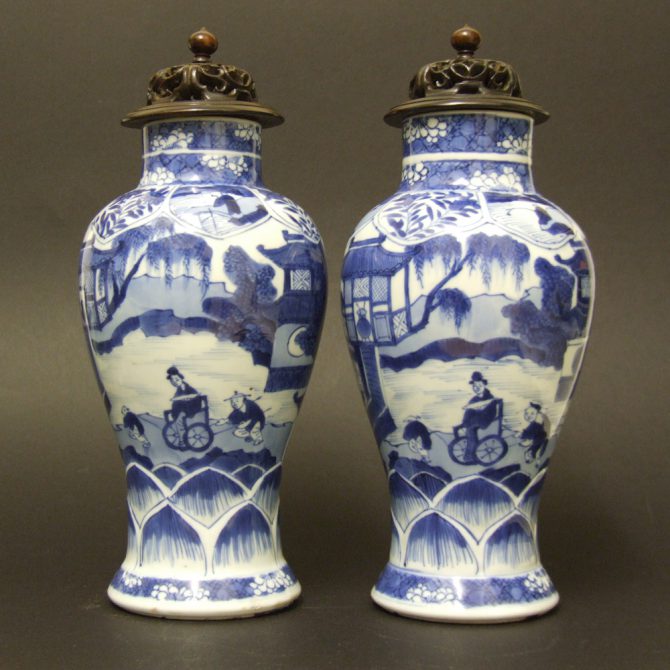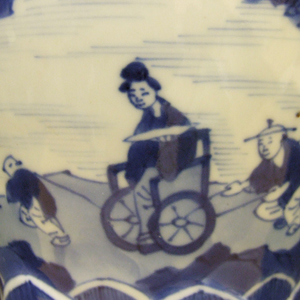
KANGXI 1662 – 1722 Chinese Export Porcelain
A Pair of Kangxi Blue and White Porcelain Vases c.1690-1720. This Pair of Chinese Export Porcelain Baluster Vases are Moulded with Lotus Petal Borders. The Decoration, Based on a Woodcut Consists of an Elegant Chinese Lady being Carried in a Two Wheeled Hand Cart, a Man on Horseback with a Large Building Complex. The Scene is Probably Taken from `The Western Chamber` and Depicts Zhang Sheng`s Sorrowful Departure from Cui Yingying. The Wooden Covers are 19th Century Chinese Replacements.
SOLD
- Condition
- One vase perfect but lacking it's porcelain cover. The other vase with a fine crack to the rim now sealed, c.27mm. Lacking it's porcelain cover.
- Size
- Height (excluding the wooded cover : 22.3 cm (8 3/4 inches)
- Provenance
- N/A
- Stock number
- 22388
- References
- For another version of this scene see : The West Chamber, A Literary Theme in Chinese Porcelain Decoration, a paper read by Mr Craig Clunas on 11th May 1982 (Transactions of the Oriental Ceramics Society 1981-1982). Page 18, a panel, porcelain decorated in enamels. Late 17th century.
Information
Romance of the West Chamber / Xi Xiang Ji :
The scene of Zhang Sheng, a young scholar clambering over a wall to meet his young lover Cui Yingying appears frequently on Chinese porcelain of the 17th and 18th century. This is the most recognisable of a large group of designs taken from the West Chamber. It is based on a scene in Act III of this famous Chinese literary work written by the Yuan Dynasty playwright Wang Shifu (c.1260-1336) it was set during the Tang Dynasty (618-907). It has had an enduring appeal, some of the very first narrative scenes decorated on Chinese blue and white porcelain are taken from this story, they were produced during the Yuan dynasty in the mid-14th century and the designs have been used ever since. The story is of young lovers consummating their love without parental approval, and has been called `China`s most popular love comedy` and a `lover`s bible`. At the same time, some have called it potentially dangerous, as there are stories of readers pining away under its influence. There are problems for those of us who wish to identify individual scenes depicted in the West Chamber, these are clearly set out by Craig Clunas in his excellent paper presented to the O.C.S. (A Literary Theme in Chinese Porcelain Decoration, a paper read by Mr Craig Clunas on 11th May 1982, Transactions of the Oriental Ceramics Society 1981-1982). He points out that it is particularly difficult to identify the designs produced during the Qing dynasty. One reason given is there are few reproductions of later editions of the work to compare the designs too, but more problematically the designer, as opposed to the painter, might well have interpreted the scene without any direct reference to the original woodcut. The designs taken from the West Chamber were especially popular during the Kangxi period (1662-1722) particularly in blue and white but they also occur frequently on famille verte of the period. The scene of Zhang Sheng clambering over a wall can be found on blue and white porcelain teaware recovered from the Ca Mau Cargo (Yongzheng period 1723-1735), this particular design was also produced at the period in famille rose enamels.



